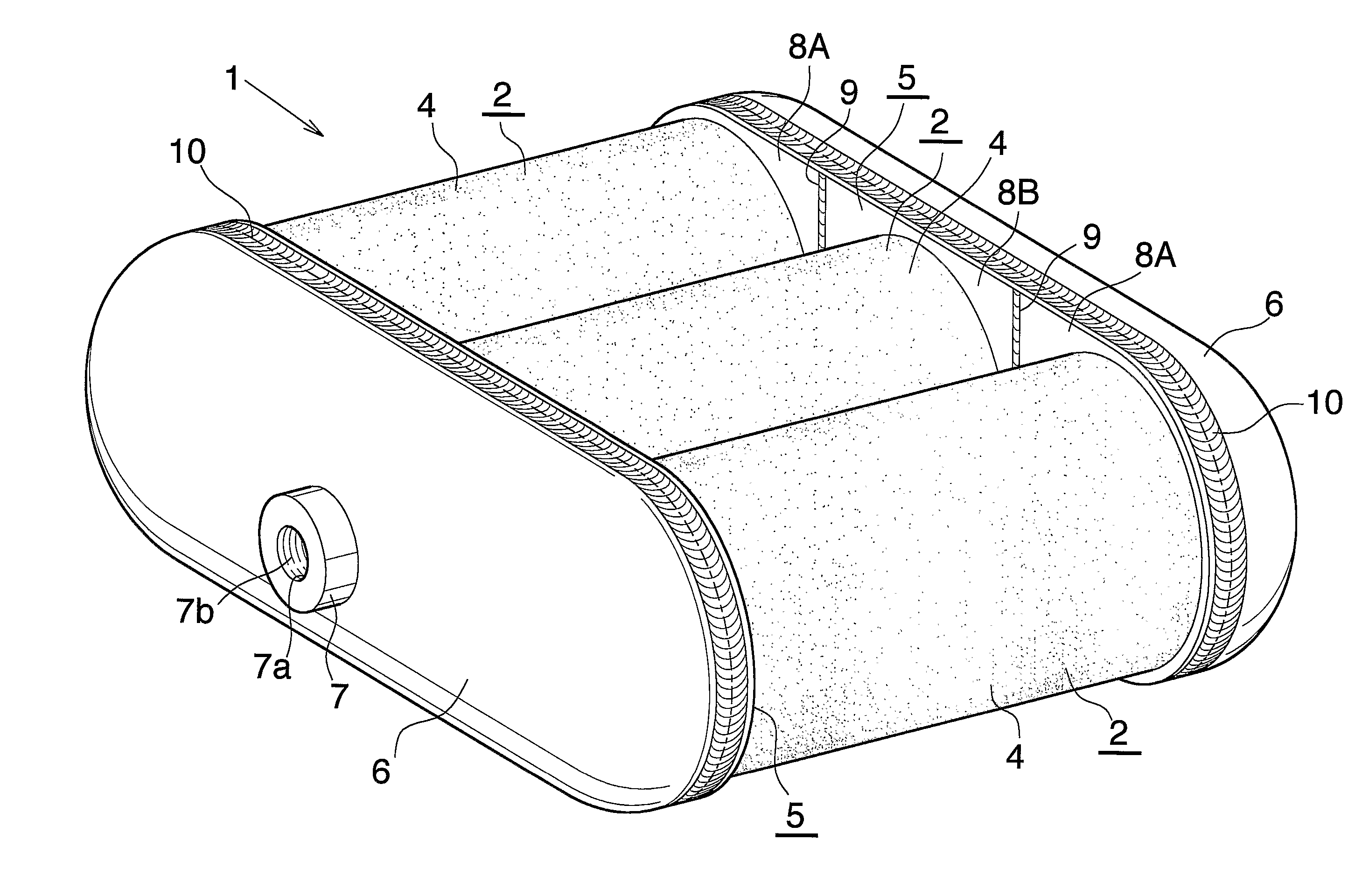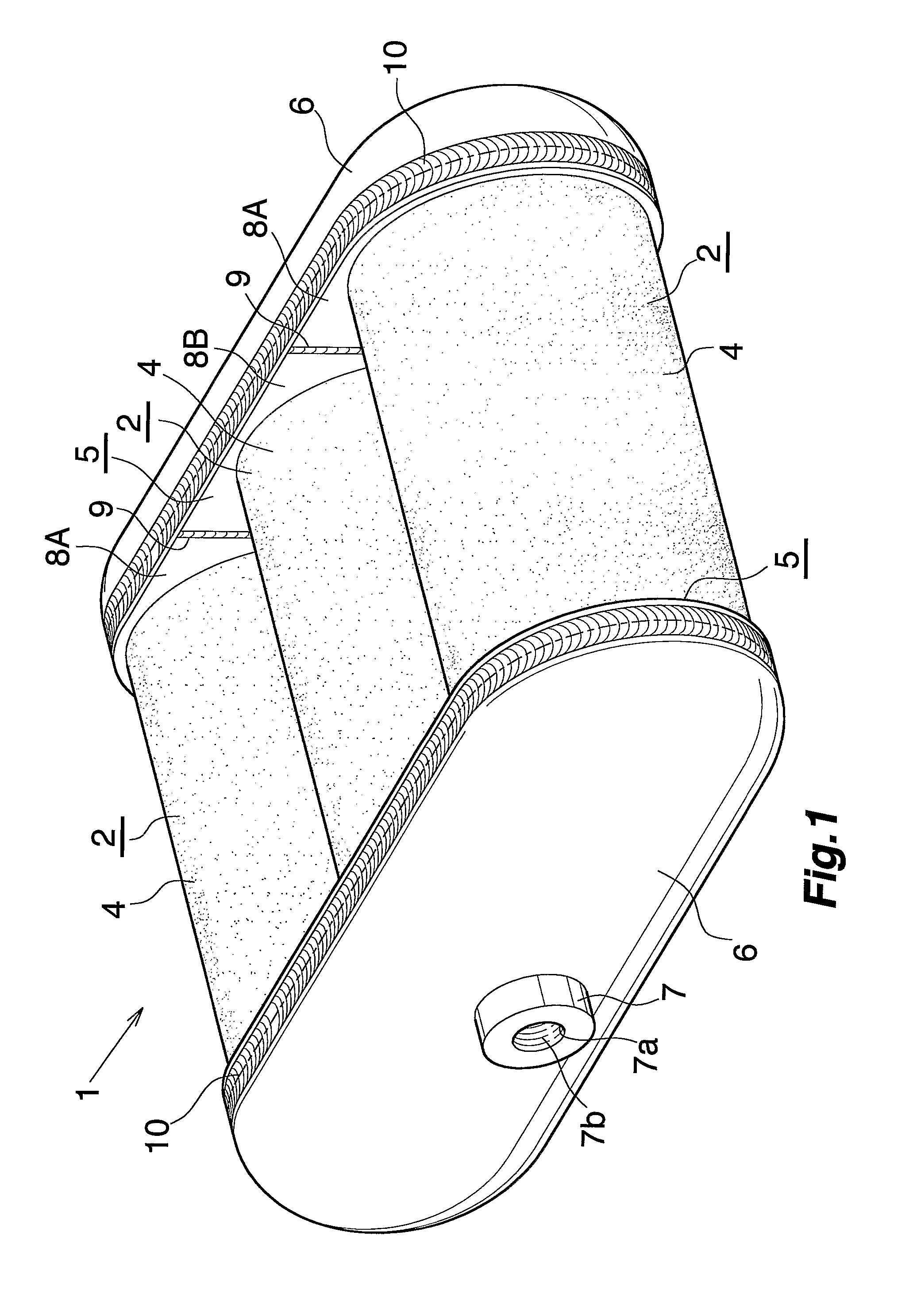Pressure Vessel
a pressure vessel and pressure technology, applied in the direction of electrochemical generators, transportation and packaging, container discharging methods, etc., can solve the problems of deteriorating the comfort of the cabin, wasting space in the car-mounted state, and inability to make effective use of free space existing in motor vehicles, so as to improve the pressure resistance and save weight. , the effect of reducing the thickness
- Summary
- Abstract
- Description
- Claims
- Application Information
AI Technical Summary
Benefits of technology
Problems solved by technology
Method used
Image
Examples
embodiment 1
[0076] This embodiment is shown in FIGS. 1 to 7. FIGS. 1 to 3 show a pressure vessel. FIGS. 4 to 6 show the method of fabricating the pressure vessel. In addition, FIG. 7 shows an example of measures for the case when a higher pressure resistance is required.
[0077] In FIGS. 1 to 3, the pressure vessel (1) comprises: a plurality of vessel structures (2) each composed of a cylindrical liner (3) made of aluminum, having openings at both ends and lying with its axis in a lateral direction, and a fiber reinforced resin layer (4) covering an outer periphery of a peripheral wall of the liner (3), the vessel structures (2) being arranged in parallel in a front-to-back direction with the axes of the liners (3) on an identical horizontal plane; end plates (5) made of aluminum, formed stationarily across both right and left ends of the liners (3) of all the vessel structures (2); and outward-bulging dome-shaped communicating members (6) made of aluminum, fixed to the respective end plates (5)...
embodiment 2
[0093] This embodiment is shown in FIG. 10.
[0094] With the pressure vessel of this embodiment, the end plates (5) are each made of a single metal plate, or aluminum plate (30) here, having through holes (31) for the open ends of the liners (3) to be fitted into. Then, both ends of the individual liners (3) are fitted into the through holes (31) in the respective aluminum plates (30). The areas of the aluminum plates (30) around the through holes (31) and the open ends of the liner (3) are joined from outside in the axial direction of the liners (3) by an appropriate method such as the friction agitation joining method. Incidentally, no fiber reinforced resin layer (4) is formed on both ends of the liners (3) where to be fitted into the through holes (31) in the aluminum plates (30). The method for joining the aluminum plates (30) and the liners (3) is not limited to the friction agitation joining method.
[0095] The aluminum plates (30) are made of, for example, any one of JIS A2000...
embodiment 3
[0097] This embodiment is shown in FIG. 11.
[0098] The pressure vessel of this embodiment does not use the end plates (5). Both ends of the liners (3) of adjoining vessel structures (2) are connected and integrated with each other by the intervention of plate-like connecting members (35) made of metal, or made of aluminum here. More specifically, semicircular notches (36) for halves of the ends of two adjoining liners (3) to be fitted to are formed in both sides of the connecting members (35) Then, the halves of both ends of the liners (3) are fitted into the notches (36) in the connecting members (35). The areas of the connecting members (35) around the notches (36) and both ends of the liner (3) are joined from outside in the axial direction of the liners (3) by an appropriate method such as the friction agitation joining method. Incidentally, no fiber reinforced resin layer (4) is formed on both ends of the liners (3) where to be fitted into the notches (36) in the connecting mem...
PUM
| Property | Measurement | Unit |
|---|---|---|
| Diameter | aaaaa | aaaaa |
| Length | aaaaa | aaaaa |
| Area | aaaaa | aaaaa |
Abstract
Description
Claims
Application Information
 Login to View More
Login to View More - R&D
- Intellectual Property
- Life Sciences
- Materials
- Tech Scout
- Unparalleled Data Quality
- Higher Quality Content
- 60% Fewer Hallucinations
Browse by: Latest US Patents, China's latest patents, Technical Efficacy Thesaurus, Application Domain, Technology Topic, Popular Technical Reports.
© 2025 PatSnap. All rights reserved.Legal|Privacy policy|Modern Slavery Act Transparency Statement|Sitemap|About US| Contact US: help@patsnap.com



